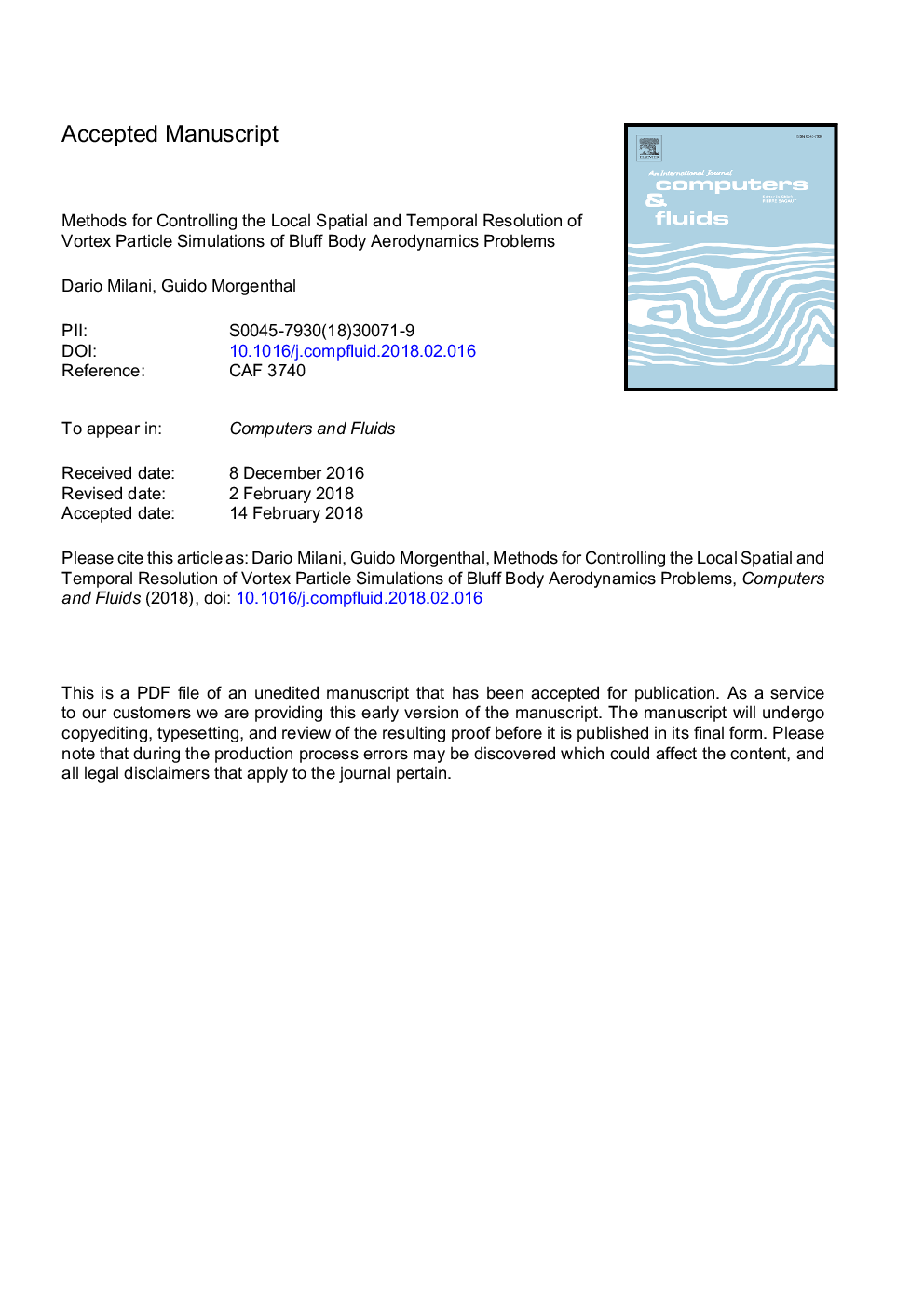| کد مقاله | کد نشریه | سال انتشار | مقاله انگلیسی | نسخه تمام متن |
|---|---|---|---|---|
| 7156353 | 1462645 | 2018 | 23 صفحه PDF | دانلود رایگان |
عنوان انگلیسی مقاله ISI
Methods for controlling the local spatial and temporal resolution of vortex particle simulations of bluff body aerodynamics problems
ترجمه فارسی عنوان
روش ها برای کنترل حل مسائل مکانی و زمانی محلی از شبیه سازی ذرات گردابی از مشکلات آیرودینامیکی بدن
دانلود مقاله + سفارش ترجمه
دانلود مقاله ISI انگلیسی
رایگان برای ایرانیان
کلمات کلیدی
انطباق، آیرودینامیک، معجزه زیرشاخه، روشهای ذرات گرداب،
ترجمه چکیده
این مقاله یک استراتژی راه حل انطباقی جدید برای روشهای ذرات گردشی ارائه می دهد که به مقابله کارآمد مقیاس های چندگانه می انجامد که ویژگی های جریان در اطراف بدنه ها با جزئیات کوچک ساختاری است. کارایی روش حاصل از حفظ یک اختلال عددی فضایی به اندازه کافی بالا در نزدیکی رابط مایع جامد و برش پیشرونده از بدن و جزئیات ساختاری آن است. کنترل ذرات ذرات از طریق تغییر مجدد بر اساس هسته های درونیابی مرتبه بالا حاصل می شود و ترسیم دقیق از ویژگی های جریان مقیاس های مختلف را می دهد که وضوح آن برای محاسبه دقیق فشار بر ساختار غوطه ور شده در جریان جریان جدا شده بسیار مهم است. به عنوان گام زمانی لازم برای ادغام زمانی به طور مستقیم با وضوح فضایی مرتبط است، تطبیق با یک سازگاری زمانی که از طریق یک تکنیک فرعی مرحله ای برای کنترل فرکانس انجام می شود که در آن مراحل نفوذ و ذوب شدن ذرات انجام می شود، بیشتر می شود. اعتبار سنجی روش پیشنهادی توسط شبیه سازی جریان مداخله ای شروع شده از یک سیلندر دایره ای در شماره 3000 رینولدز انجام می شود که در آن هر دو استراتژی فضایی و زمانی به طور مستقل مورد مطالعه قرار می گیرند و سپس به سازگاری کامل متصل می شوند. کارایی محاسباتی بطور قابل توجهی در مقایسه با شبیه سازی غیرقابل انطباق دقیق گزارش شده است. مطالعات بیشتر در مورد دقت و کارایی با شبیه سازی جریان جریان متقاطع یک هندسه قوس پل با جزئیات کوچک ساختاری انجام می شود. خواص راه حل شامل حل و فصل پروفیل سرعت محلی و ضریب آیرودینامیکی جهانی است. این نشان می دهد که چگونه کاربرد استراتژی سازگار کامل را قادر می سازد برای پیش بینی دقیق و کارآمد از ویژگی های جریان. نتایج حاصل از مقایسه ی رویکرد جدید به روش ذرات کلاسیک گرداب نشان می دهد که سرعت بالا تا عامل 4 تا 5 برابر است.
موضوعات مرتبط
مهندسی و علوم پایه
سایر رشته های مهندسی
مکانیک محاسباتی
چکیده انگلیسی
This paper presents a novel adaptive solution strategy for vortex particle methods that allows the efficient resolution of multiple scales that are characteristic of flows around bluff bodies with small structural details. The efficiency of the method arises from maintaining a sufficiently high spatial numerical discretisation near the fluid-solid interface and a progressive coarsening away from the bodies and their structural details. The control of the particle map is achieved through remeshing based on high-order interpolation kernels and ensures an accurate representation of the flow features of different scales whose resolution is critical to an accurate computation of the pressures on the immersed structure subjected to separated flows. As the required time step of the time integration is directly related to the spatial resolution, the adaptivity is further enhanced by a temporal adaptivity realized through a sub-stepping technique for controlling the frequency at which the particle convection and diffusion steps are performed. The validation of the proposed technique is performed by simulations of the impulsively started flow past a circular cylinder at Reynolds number 3000, where both the spatial and the temporal strategies are at first independently studied and then combined to full adaptivity. A substantially higher computational efficiency compared to equally accurate non-adaptive simulations is reported. Further studies of accuracy and efficiency are performed by simulating the flow past the cross section of a bridge arch geometry featuring small structural details. Solution properties studied include the resolution of local velocity profiles and global aerodynamic coefficients. These reveal how the application of the full adaptive strategy enables for the accurate and efficient prediction of the flow features. The results indicate speed-ups of up to factor 4 to 5 when comparing the new approach to the classical Vortex Particle Method.
ناشر
Database: Elsevier - ScienceDirect (ساینس دایرکت)
Journal: Computers & Fluids - Volume 166, 30 April 2018, Pages 225-242
Journal: Computers & Fluids - Volume 166, 30 April 2018, Pages 225-242
نویسندگان
Dario Milani, Guido Morgenthal,
